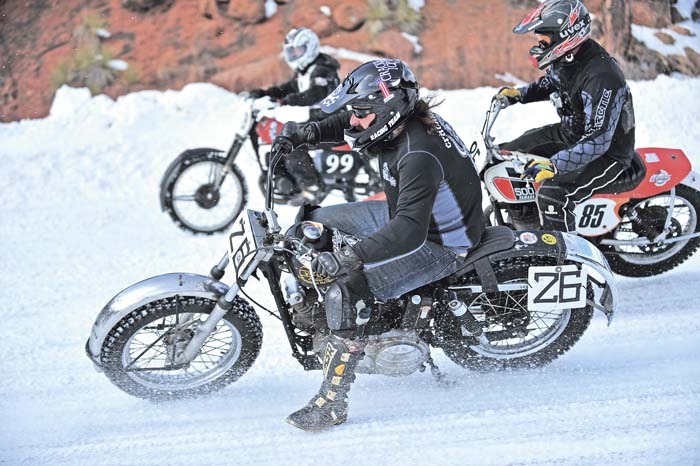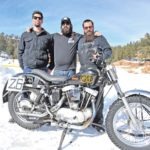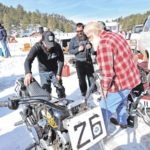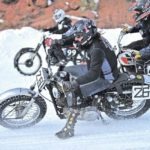It was easy to hear there was something different happening at the final day of motorcycle ice racing at Rainbow Falls Park near Woodland Park, Colorado, on February 12. It wasn’t just the distinct thump of Milwaukee Iron, either.
“I just got beat by a Harley!” exclaimed Shawn Seckman, of Colorado Springs, as he rode into his pit area. “That hurts!”
It was true. Seckman and his Honda dirt bike had just been outrun by a 1968 Ironhead Sportster—on a frozen lake to boot.
Seckman wasn’t the first victim of the Milwaukee heavy-metal lake monster, just the most recent. Piloted by racing veteran and full-time biker Nikolas Pew of Denver, the Sporty has picked off unsuspecting racers throughout the January and February race season.
“It just eats ’em up,” said an exuberant Pew in his pit area after the first race of the day. “First a Honda, then a Yamaha, then another Honda, then another, and another. It just knocks ’em off going around the lake. And everybody I pass is looking around like, ‘Huh?’ wondering if it was real.”
Everyone in the pit laughed and reveled in the success of the 44-year-old Ironhead against the lighter, more agile—but evidently not always faster—import bikes that dominate the ice races.
They had a right to be happy. Up until late 2011, the Sporty had been sitting in a front yard collecting dust and rust… for better than 20 years. But Nikolas, his brother and fellow racer Walker and friend Nick LaBriola had managed to bring Harley-Davidson back to the ice successfully. The three are part of the original Cracker Boys Race Team, which has been terrorizing and dominating the race scene off and on since the guys were just youngsters. Joined by friends and other members of Cracker Boys, the Sportster was nursed back to life specifically to run on the ice again—“again,” because ice racing is what the bike was originally built for in the early 1980s.
Rick LaBriola of LaBriola Machine in Denver built the bike with Rick Pew and ice racer Rich Wykoski while the pair worked at 2-Wheelers Motorcycle Shop in Denver.
“We sponsored Rich,” Rick explained. “I told him we couldn’t give him any money but we’d give him all the parts he could burn up and help him with the mechanical work. That was 30 years ago. Nikolas and Walker were just little kids, like pre-schoolers, and my son Nick was a baby. I never thought the bike would still be running, let alone that those three kids would be racing it.”
The bike raced for several seasons before eventually winding up as yard art in Lafayette, Colorado, for 22 years. In late 2011, Rick LaBriola approached Wykoski about displaying the racer in his new shop.
“At first I just wanted it as a historical display in my new shop.” Rick explained. “But when we went out to Lafayette with some gas and a new carb, that thing fired right up and was ready to go. That’s when I decided this bike didn’t want to be a museum piece; it wanted to race. I said, ‘Forget using it as a display, I know someone who will race it.’”
Enter the Cracker Boys.
“We had to do a little bit of work to get it running and make a few changes to make it race legal,” Nikolas explained. “It had a lot of problems. The tires were dry rotted, we put a new top end on it, and pretty much went through the whole bike. My dad (Rick Pew) and Rick LaBriola were a big help.”
Then came the process of blowing all the cobwebs out. As the season progressed, the bike kept revealing problems.
“There’s a lot of vibration, and after sitting for 20 years, all the little things started to show,” Nikolas explained. “It seemed like every week we had some new problem.”
The team dove in and solved every issue. They put a Mikuni carb on the bike, lowered the front end two inches, found the right tires to run with studs, and found fenders for the old beast.
“We had to put fenders on it,” Nikolas explained. “Back in the day they didn’t have to have fenders on the bikes. Now, there has to be a fender that comes down at least even with the axle. We weren’t going to put some plastic dirt bike fenders on it, so it took a little bit to find metal fenders that were right, but we got ’em and got everything set up. It looks pretty tough.”
That look, coupled with the unique sound of a Harley, got the Ironhead a lot of attention out at the lake.
“It’s pretty beefy,” Nikolas said. “We kept the old tank with the hand-painted logo on it and tried to keep the look as true to what it was when this bike first came out here [Rainbow Falls Park] in the ’80s.”
They succeeded. The black Sporty with piecemeal chrome fenders and a big K&N air filter hanging off the side is an intimidating sight. Add the powerful pop and low growl of the 1000cc Harley power plant, and other racers take pause to look… and perhaps worry.
“It’s running good now,” Nikolas explained. “Everyone out here wanted to see it running and for us to get it out on the ice. Now that we’re doing that, there’re a lot of people being surprised. When I roll through the pack, there are some guys that get out of the way. There aren’t many riders who want to try and bump me. This bike’s not moving. It’s heavy and solid. The intimidation factor seems to be working.”
In a sport notorious for riders banging each other out of the way, running the Ironhead is creating a new dynamic. Racing in the Vintage Open Class, the Ironhead with heavily studded tires is more like a 1000cc buzz saw running with the much smaller import racers.
“Most the bikes in that class are single cylinder 250cc or 500cc bikes,” Nikolas pointed out. “This bike is two cylinders and twice the size and weight. I have a lot of power, which isn’t always a good thing on this small track, but I can really power through if I need to.”
The other result of running the ’68 on the ice is the interest it’s generating. The races are as much about having fun as winning, and there is genuine interest in seeing a Harley street bike—not really an ice bike—run hard against the little bikes. Then there’s the nostalgia factor. The bike has been the talk, and interest, of the ice racing community this year. What’s more, word has spread beyond the race lake.
“There’s been a lot of the old-school Harley guys come out who want to see it,” Nikolas said. “It’s a typical old Harley. It fouls out or has some kind of problem about every other race. We fix it and keep going. It’s really not that bad. Plus, I have Walker and Nick here to help. It’s running good now, though.”
That’s noticed by the competition.
“That guy has got to be the busiest guy out here,” said Seckman, the rider who couldn’t believe he got beat. “He keeps that thing running real strong. It’s a little scary; that’s a big bike and that dude can ride.”
Seckman, like most everyone out for the races, likes seeing the Ironhead on the ice.
“I like seeing it out here,” Seckman said. “It’s awesome… it’s poetry, really. I think we all like to see those old bikes the guys are able to keep running out here racing. That’s what this is all about. I don’t think anyone expected that he would be ripping it up like he is on an old Harley. It’s pretty cool.”
While Seckman lost his first race to Nikolas and the Ironhead, he squeaked out a win in the second race of the day.
“I crossed the finish line with a big smile on my face,” Seckman said. “But I was looking over my shoulder. I expected him to power past me any second. Homie can ride, I’m tellin’ ya.”
Meanwhile, Nikolas popped open a frosty beverage to celebrate a successful day with the Ironhead on ice.
“The bike ran strong, I didn’t crash, and people are talking about this bike and are still in awe,” Nikolas said, taking a drink. “It’s a good day.”























